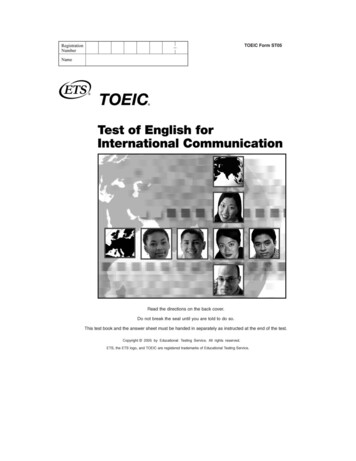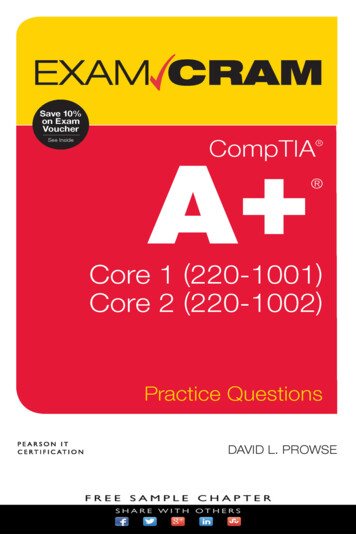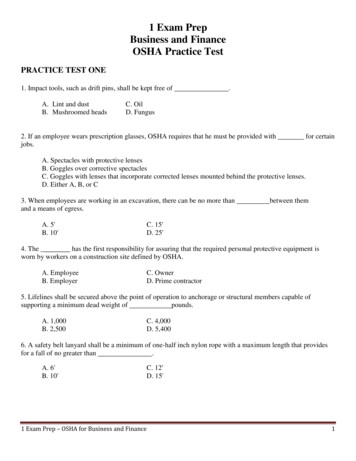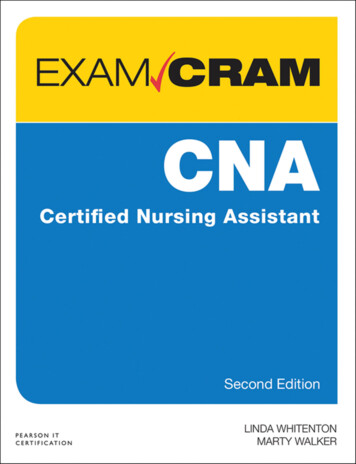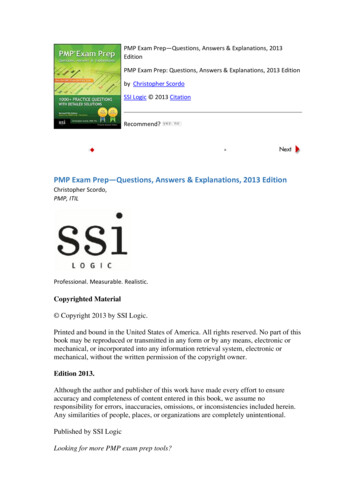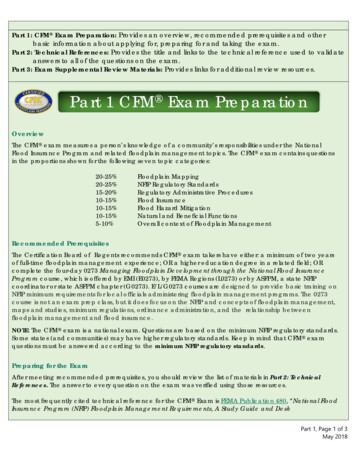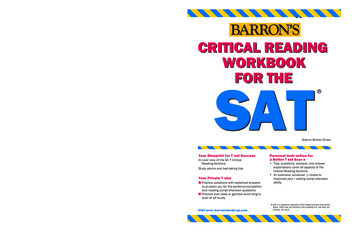
Transcription
Practice Exam Answer KeyGRADING KEYThis examination has the following six parts:Part A: Multiple‐choice questions (30 marks)Part B: Nonexperimental briefs (10 marks)Part C: Computing a correlation coefficient (10 marks)Part D: Key concepts in Research Methods (15 marks)Part E: Experimental briefs (10 marks)Part F: Design an experimental study (25 marks)Published by TRU Open Learning under the Creative Commons Attribution-Share Alike 3.0Unported license, allowing you the freedom to reuse provided proper attribution is maintained andthe requirement to distribute any modifications under the same, similar, or compatible terms.
Introduction to Research Methods In Psychology1Part A: Multiple-choice questions (30 marks)This part includes 30 questions, each of which is worth 1 mark.1. An example of an operational definition for anxiety is a:a. score on an anxiety questionnaireb. person’s description of anxietyc. how tense or nervous a person is presently feelingd. punctuality2. The most accurate research method of determining whether caffeinesupplements improve memory performance isa. case studyb. correlational studyc. experimental studyd. naturalistic observation3. An elasticized measuring tape is used to measure a child’s waist. In the firstmeasurement, the tape is stretched tightly. In the second measurement, the tapeis held loosely. This is a good example of:a. poor test‐retest reliabilityb. good test‐retest reliabilityc. good alternate forms reliabilityd. poor alternate forms reliability4. Researchers find a correlation of 1.20 between coffee consumption and mentalalertness. This indicates that:a. drinking more coffee is associated with mental alertnessb. drinking less coffee is associated with mental alertnessc. there is a flaw in the computation of the correlation coefficientd. drinking coffee increases mental alertnessPublished by TRU Open Learning under the Creative Commons Attribution-Share Alike 3.0Unported license, allowing you the freedom to reuse provided proper attribution is maintained andthe requirement to distribute any modifications under the same, similar, or compatible terms.
2Practice Exam5. Evidence reveals a correlation between the number of hours toddlers spendwatching television and their level of hyperactivity in later childhood. Whatdoes this definitively indicate?a. that television watching causes hyperactivityb. that hyperactive children watch televisionc. that parents of hyperactive children rely on television as a means ofmanaging hyperactivityd. that there is a relationship between television viewing and hyperactivity6. An advantage of the case study method isa. it allows for definitive conclusionsb. it is hypothesis generatingc. it is hypothesis confirmingd. it allows for broad conclusions7. The standard deviation tells us?a. how much, on average, individual scores differ from the meanb. how much, on average, individual scores differ from one anotherc. the midpoint of individual scores in a distributiond. the distance between the highest and lowest individual scores in adistribution8. The results of a study are found to be statistically significant. This means thata. the researchers have proven their hypothesesb. the results are greater than what would be expected by chancec. the study was conducted flawlesslyd. there was a large difference between the experimental and control groupson the dependent variablePublished by TRU Open Learning under the Creative Commons Attribution-Share Alike 3.0Unported license, allowing you the freedom to reuse provided proper attribution is maintained andthe requirement to distribute any modifications under the same, similar, or compatible terms.
Introduction to Research Methods In Psychology39. Researchers manipulate or control variables in order to conducta. naturalistic observation.b. the double‐blind procedure.c. case studies.d. a true experiment.10. Which of the following is the strongest correlation coefficient?a. 0.50b. ‐0.92c. ‐0.75d. 0.7511. Researchers studied language development in the same group of children everyyear over a five‐year period. This research design is called:a. cross‐sectionalb. longitudinalc. placebo‐controlledd. correlational12. Calculate the median of the following distribution of scores: 5, 2, 3, 8, 1, 4, 5a. 4b. 5c. 4.5d. 813. Calculate the mode of the following distribution of scores: 5, 2, 3, 8, 1, 4, 5a. 4b. 5c. 4.5d. 8Published by TRU Open Learning under the Creative Commons Attribution-Share Alike 3.0Unported license, allowing you the freedom to reuse provided proper attribution is maintained andthe requirement to distribute any modifications under the same, similar, or compatible terms.
4Practice Exam14. In science, a theory is a(n)a. strongly held opinionb. specific prediction about causal factorsc. testable explanation for a set of observationsd. scientific law15. Jasmeet is interested in conducting an experiment in which she manipulates theamount of food she gives her Siamese fighting fish. She ensures that the size ofthe fish tank is identical for each fish, and that fish are assigned into groupsrandomly. What aspect of this experiment has Jasmeet not worked out?a. Independent variablesb. Confounding variablesc. Dependent variablesd. Sampling bias16. To avoid experimenter bias and subject bias researchers employa. the single‐blind procedureb. the double‐blind procedurec. random samplingd. the naturalistic observation method17. A concern when using self‐report measures is:a. the hindsight biasb. reaction time validityc. the social desirability biasd. a small sample sizePublished by TRU Open Learning under the Creative Commons Attribution-Share Alike 3.0Unported license, allowing you the freedom to reuse provided proper attribution is maintained andthe requirement to distribute any modifications under the same, similar, or compatible terms.
Introduction to Research Methods In Psychology518. Researchers are testing baby James’ ability to recognize his mother’s face. Jamesis presented with an image of his mother’s face and a stranger’s face. Theresearchers examine how long James looks at each image. What type of measureare the researchers using?a. self‐reportb. report by othersc. behaviorald. physiological19. What would be the best method for studying the situations in which people picktheir nose?a. case studyb. naturalistic observationc. correlational methodd. experimental method20. What would be the best method for examining the relationship between age anddriving behavior?a. case studyb. naturalistic observationc. correlational methodd. experimental method21. Uncontrolled factors that can reduce internal validity are termed .a. Dependent variablesb. Bias variablesc. Subject variablesd. Confounding variablesPublished by TRU Open Learning under the Creative Commons Attribution-Share Alike 3.0Unported license, allowing you the freedom to reuse provided proper attribution is maintained andthe requirement to distribute any modifications under the same, similar, or compatible terms.
6Practice Exam22. Science deals in not ; therefore, science cannot dealin absolute .a. induction; deduction; truthb. deduction; induction; falsificationc. induction; deduction; falsificationd. deduction; induction; truth23. Testing the reliability of a psychometric instrument by dividing the test itemsinto two arbitrary groups and correlating the scores obtained in the two parts ofthe test is termed:a. Split‐half reliabilityb. Parallel forms reliabilityc. Test‐retest reliabilityd. Half‐form reliability24. Factorial designs are designs with more than one:a. independent variableb. dependent variablec. significant interactiond. significant main effect25. In a 2 x 3 factorial design there are treatment conditions.a. 2b. 5c. 6d. There is insufficient information to answer this question26. When different participants are randomly assigned to each of the conditions it istermed:a. An independent groups designb. A repeated measures designc. A mixed designd. A matched groups designPublished by TRU Open Learning under the Creative Commons Attribution-Share Alike 3.0Unported license, allowing you the freedom to reuse provided proper attribution is maintained andthe requirement to distribute any modifications under the same, similar, or compatible terms.
Introduction to Research Methods In Psychology727. In quasi‐experimental research:a. Researchers have no direct control over the independent variablesb. There are subject variablesc. Causal statements are not possibled. All of the above28. You read in the newspaper that Vancouver has been ranked as the second bestcity in the world in which to live. What kind of scale is being used here?a. Ratiob. Nominalc. Intervald. Ordinal29. The following outcome of a factorial design indicates:a. A main effect of A, a main effect of B, and an interactionb. A main effect of A, a main effect of B, and no interactionc. A main effect of A, no main effect of B, and no interactiond. No main effect of A, a main effect of B, and no interactionPublished by TRU Open Learning under the Creative Commons Attribution-Share Alike 3.0Unported license, allowing you the freedom to reuse provided proper attribution is maintained andthe requirement to distribute any modifications under the same, similar, or compatible terms.
8Practice Exam30. The following outcome of a factorial design indicates:a. A main effect of A, a main effect of B, and an interactionb. A main effect of A, a main effect of B, and no interactionc. A main effect of A, no main effect of B, and no interactiond. No main effect of A, a main effect of B, and no interactionPublished by TRU Open Learning under the Creative Commons Attribution-Share Alike 3.0Unported license, allowing you the freedom to reuse provided proper attribution is maintained andthe requirement to distribute any modifications under the same, similar, or compatible terms.
Introduction to Research Methods In Psychology9Part B: Nonexperimental briefs (10 marks)Read the following descriptions of two nonexperimental studies. For both studies,answer the questions listed below. Each answer is worth 2.5 marks, for a total of 10marks.A. Ilan suspects that there is a relationship between the amount of choice peoplehave when making a decision and their satisfaction with their eventualchoice. He decides to study this question outside two ice‐cream shops locatedin different parts of the city. Store A offers a choice of six flavours of icecream whereas Store B offers a choice of thirty flavours of ice cream. For thesame two‐week period, Ilan positions his research assistants outside bothstores between 3pm and 6pm. The research assistants approach customerswho have just purchased some ice cream as they are leaving the store,introduce themselves and invite them to complete a brief questionnaire. Oneof the questions on the questionnaire asks the customers to rate their level ofsatisfaction with the ice cream. Statistical analyses show that the customersthat bought their ice cream from Store A were more satisfied than those thatbought their ice‐cream from Store B.B. Sam is a graduate student who is interested in whether being extravertedcauses people to have more friends on Facebook. He recruits a large numberof students at his university to participate in his study. Before the studybegins, the students give the research team permission to temporarily accesstheir Facebook profile page. Sam gets four of his research assistants (none ofwhom know any of the participants personally) to browse through each ofthe Facebook profile pages and to record how many Facebook friends eachstudent has. Sam also requests the students to complete a detailedquestionnaire that accurately measures how extraverted they are. When Samlooks at both sets of scores he concludes that the being extraverted does causepeople to have more Facebook friends.Published by TRU Open Learning under the Creative Commons Attribution-Share Alike 3.0Unported license, allowing you the freedom to reuse provided proper attribution is maintained andthe requirement to distribute any modifications under the same, similar, or compatible terms.
10Practice Exam1. Describe the type of nonexperimental research used in this study. How do youknow this? (2.5 marks)A. This is a quasi‐experimental study (1 mark).We know this because, although the study has an independent variable(the amount of choice), the participants were not randomly assigned totheir condition. (1.5 marks)B. This is a correlational study (1 mark).We know this because the researchers are measuring two variables(number of Facebook friends & self‐reported extraversion) among a groupof participants and then examining the relationship between them(1.5 marks).2. Describe one threat to internal validity faced by this study design. In youropinion what is the best way to overcome or account for this threat? (2.5 marks)A. Selection of participants is the biggest threat to internal validity in thisstudy (there may be pre‐existing differences between the two groups ofparticipants such as their level of income). One possible solution would beto restrict the sample to people from the same age range (or otherdemographic characteristics).Another possible answer concerns a confounding variable like the qualityof ice cream across the two shops. The students might suggest holding thequality of ice‐cream constant (e.g., by conducting the study at the samestore but having a different number of available choices on different days)or measuring the customer‐rated quality and controlling for it statistically.Some students may also suggest designing an experimental study in whichparticipants are randomly assigned to one of the two conditions.B. Because correlation does not equal causation, Sam cannot be certain thatbeing extraverted is what caused his participants to have more Facebookfriends (e.g., a third variable like openness to new experiences might havecaused both). Social desirability might also have affected how participantscompleted the extraversion questionnaire (they might have wanted toappear more extraverted than they really are).In some cases these additional variables may be measured and statisticallycontrolled, or sub‐groups (e.g., those above & below average on opennessto experience) analyzed separately.Published by TRU Open Learning under the Creative Commons Attribution-Share Alike 3.0Unported license, allowing you the freedom to reuse provided proper attribution is maintained andthe requirement to distribute any modifications under the same, similar, or compatible terms.
Introduction to Research Methods In Psychology11Part C: Computing a correlation coefficient (10 marks)Professor Aknin is interested in the relationship between charitable giving (i.e., howmuch money people donate to charity) and happiness. She administers aquestionnaire for life satisfaction among a sample of 5 people and also asks them toestimate how much money they donated to charity over the past year. The datacollected are as follows:Life satisfactionApproximate amount donated to charity24 60029 40014 2020 801. Compute the correlation for these data and show your work. In determiningyour answer, show your computation and follow the correct procedure. For fullmarks, values must exactly equal the correct values. (10 marks)Formula for computing a correlation:1 mark for each correct computation of: Sum of x 87 Sum of x squared 2013 Sum of y 1100 Sum of y squared 526800 Sum of xy 278803 marks for correct procedure (values correctly plugged into the formula,correct computation of each of the elements of the formula)2 marks for correct answer (to at least two decimal places):r .7599 (or just rounded to .76)Published by TRU Open Learning under the Creative Commons Attribution-Share Alike 3.0Unported license, allowing you the freedom to reuse provided proper attribution is maintained andthe requirement to distribute any modifications under the same, similar, or compatible terms.
12Practice ExamPart D: Key concepts in Research Methods (15 marks)This section evaluates your understanding of four key concepts in the course andcomprises 15 percent of your grade on the final examination. Each of the four tasksin this section is worth 5 marks. Do not answer all of the questions. Choose andanswer only three of the four questions.1. Discuss five threats to internal validity in studies that involve repeated testing(e.g., pretest‐posttest, repeated measures, etc.). (5 marks)1 mark for each threat properly described.Possible threats to internal validity are: history, maturation, testing, mortality,regression to the mean, and instrumentation.2. List two advantages and two limitations (each) of case studies and quasi‐experimental research. (5 marks)0.625 marks for each advantage and each limitation of case studies and quasi‐experimental research. See Unit 3 for some possible answers.3. Describe four ways that you could improve the reliability of a study. (5 marks)1.25 marks for each way that reliability could be improved, up to a maximumof 5 marks. Possible ways to improve reliability (there are many ways so allowsome latitude): Automate the procedure (e.g., with computers) Train the researchers carefully and only keep those who are consistentduring training Use more objective measures (e.g., count behaviors instead of rating theintensity of the behaviors) Ensure that the testing environment does not vary with repeated testingPublished by TRU Open Learning under the Creative Commons Attribution-Share Alike 3.0Unported license, allowing you the freedom to reuse provided proper attribution is maintained andthe requirement to distribute any modifications under the same, similar, or compatible terms.
Introduction to Research Methods In Psychology134. Give an example of how a laboratory experiment can be valid but have lowgeneralizability. Name at least four types of validity in your example. (5 marks)2 marks for discussing at least four different types of validity. The validitytypes can include but are not limited to: internal, external, construct,ecological, predictive, discriminate, face, convergent etc.3 marks for describing how an internally valid experiment can lack ecological,external, and predictive validity (or other types) outside the confines of thelaboratory.Published by TRU Open Learning under the Creative Commons Attribution-Share Alike 3.0Unported license, allowing you the freedom to reuse provided proper attribution is maintained andthe requirement to distribute any modifications under the same, similar, or compatible terms.
14Practice ExamPart E: Experimental briefs (10 marks)Part E contains two experimental briefs and is worth 10% of your final exam grade.Answer the sets of questions associated with each brief.Brief 1 (2 marks)Dr. Nervous was interested in the effects of caffeine on sleep. She randomly assigned20 university students (10 men and 10 women), all of whom were healthy and ofaverage weight, to four groups. The control group drank decaffeinated coffee, andthe other three groups drank one, two, or three cups of coffee. She found that peopletook longer to fall asleep after they drank more coffee. Based on this study, provideone example of each of the following variables:a. Dependent variableTime taken to fall asleep (0.5 mark)b. Independent variableAmount of coffee consumed by the participants (0.5 mark)c. Control variableAll university students; average weight; healthy, etc. (0.5 mark)d. Extraneous or confounding variableAge; typical daily coffee consumption, etc. (they can be creative here) (0.5 mark)Brief 2 (8 marks)You have developed an online test of “true” love. However, you are concernedabout the validity of your test; you are not sure it actually measures true love. Brieflydescribe four different types of convergent validation studies that you could do tomake sure that your study measures true love.2 marks for each circumstance as follows, up to a maximum of 8 marks: Predictive validity—relates one measure of behavior to another; criterionmeasure Construct validity—refers to the extent to which variables accuratelyreflect/measure the behavior External validity—refers to the extent to which observations can begeneralized to other settings and subjects Internal validity—refers to whether one can make causal statements aboutthe relationship between variablesPublished by TRU Open Learning under the Creative Commons Attribution-Share Alike 3.0Unported license, allowing you the freedom to reuse provided proper attribution is maintained andthe requirement to distribute any modifications under the same, similar, or compatible terms.
Introduction to Research Methods In Psychology15Part F: Design an experimental study (25 marks)This part of the exam requires you to design a research experiment and is worth 25%of your final exam grade.Hypokinetic disease is caused by insufficient activity and lack of regular exercise.Coronary heart disease, diabetes, high blood pressure, lower back problems, jointdisorders, and obesity are just some facets of hypokinetic disease.Research has shown that if a person does not start a consistent pattern of physicalexercise as an adolescent or young adult, they are unlikely to develop the habit later.Imagine that you have been asked to design an experiment to increase physicalactivity in adolescents. You have reasonable access to funds and resources, but yourstudy must be practical and feasible. Therefore, you will not be able to test all peopleand try all ways of increasing exercise. However, you should be able to identifysome aspects of physical activity and think of some ways that might increase it forthe long run. The following questions raise some of the important issues that youshould consider when designing a longitudinal study.Answer all of the following eight requests based on your design of an experiment. Ineach case, clearly state your reasons for your answers. In other words, justify youranswers.Students may find Part F difficult because it is at the end of a long exam and thereare many possible answers to some of the questions. It is possible for a student tosuccessfully devise an experiment that has little overlap with the guidelinesoutlined in this portion of the answer key. Therefore, it is critical that the OLFMrely on his or her own expertise and common sense. The guidelines offered hereare meant to be exemplary, not required. Keep in mind that no single experimentis definitive, and all aspects of good research design cannot be addressed in asingle answer here.1. State the hypothesis of your experiment. (2 marks) Hypothesis given is a cause‐and‐effect statement, not a question.(1 mark) Hypothesis clearly states independent variable. (0.5 mark) Hypothesis clearly states dependent variable. (0.5 mark)Published by TRU Open Learning under the Creative Commons Attribution-Share Alike 3.0Unported license, allowing you the freedom to reuse provided proper attribution is maintained andthe requirement to distribute any modifications under the same, similar, or compatible terms.
16Practice Exam2. Who will your subjects be, and how will you select them? (3 marks) Participants should be young. (e.g., adolescents or young adults)(1 mark) Participants should include inactive overweight youth as well asinactive thin youth. (1 mark) Participants could be selected in many ways; including convenience(e.g., volunteers responding to advertisement, recruitment at schools).(1 mark) Exclude potential participants. For example, exclude those who havemedical problems or those who are already participating three times aweek or more in physical activity programs. (1 mark)3. Describe your experimental situation (e.g., laboratory, schoolyard, citystreets, etc.) and why you chose this situation. (3 marks)Of importance here is not just the situation chosen but the reasons for thischoice. Most choices could be justified for marks. Examples of reasons thatwould garner marks: A laboratory was chosen because it afforded increased control andinternal validity. A laboratory was chosen because measurement of dependentvariable(s) could be more reliable (e.g., actual sedentary behavior couldbe directly observed over a period of time). Office cubicles could be used for increased external validity (i.e., morerealistic situation with increased generalizability to “real world”sedentary behaviors). To increase external and internal validity, lack of exercise/movement(sedentary) behavior was tested in several environments (convergingoperations).Published by TRU Open Learning under the Creative Commons Attribution-Share Alike 3.0Unported license, allowing you the freedom to reuse provided proper attribution is maintained andthe requirement to distribute any modifications under the same, similar, or compatible terms.
Introduction to Research Methods In Psychology174. Describe your independent variable(s) and the number of levels of eachvariable (be specific). (3 marks) Should state a variable here that is manipulated and differentiategroups (between‐subjects) or conditions (within‐subjects). For example,one group receiving education in a classroom on the harmful effects ofnon‐movement (sedentary) behavior, one group receiving education onhow to say “yes” to peers who pressure them to go for a walk, play asport, or just get active, and a control group receiving a sham treatment(e.g., classroom education on cooking techniques) would garner marks.Both the variable (e.g., education) and levels (e.g., in the above example)need to be specified. If the student only gives non‐manipulated variables (e.g., specifies aquasi‐ experimental design comparing people who donʹt exercise atdifferent ages or different levels of exercise) they should only receive1.5 marks. However, combining manipulated and non‐manipulatedvariables could get full marks.5. Describe your dependent variable(s). (3 marks) Students should state a variable here that is reliable, valid, andsensitive (e.g., death from inactivity would likely suffer from flooreffects, and judging enjoyment of not moving using subjectivemeasures may not be reliable). Most studies would benefit frommultiple dependent variables. A weaker answer might only include onemeasurement such as the number of minutes of exercise per day. For laboratory situations, wanting to exercise e.g., using a Likert scale),number of minutes of exercise per day, or the amount of strenuousexercise per day, or type and amount of exercise per day may all beincluded. For semi‐controlled (e.g., schoolyard) and realisticenvironments, similar measures as laboratory could be included.Published by TRU Open Learning under the Creative Commons Attribution-Share Alike 3.0Unported license, allowing you the freedom to reuse provided proper attribution is maintained andthe requirement to distribute any modifications under the same, similar, or compatible terms.
18Practice Exam6. What type of experiment (e.g., before‐after, between‐subjects, within‐subjects,repeated measures) will you use? Briefly explain why you chose this type.(4 marks) Basic choice is either a within‐ or between‐subject design. Within‐subject design has the advantage of controlling between‐subjectconfounds (i.e., in a within‐subject design, conditions involve the samepeople who serve as their own control) but has several limitationsincluding practice and fatigue effects. For this study, this may be areasonable choice as one could compare dependent variables (e.g., ratesof working out) before and after treatment. Between‐subject design may be a cleaner and a better choice becausepractice and fatigue effects are less of a concern but this designtypically requires more participants.A pretest‐posttest design (without a control group) is inappropriate.7. Give an example of a possible confound and how you will control it.(4 marks)Within‐subject designs have problems including fatigue and practiceeffects, which can be reduced with extensive habituation/familiarizationphases and evaluated with counterbalancing of the order of the levels ofthe independent variables.Subject bias may be a problem because inactive participants may becomemore active simply based on their expectations, not based on theirexposure to the actual independent variable. A placebo condition (arealistic sham condition that did not work though it appeared to thesubjects that it was effective) could help control this.Experimenter bias may be a problem because inactive participants may beshown to increase their activity rates as a result of biased observation andrecordings of the researcher. Objective measures and double‐blindprocedures would help control this bias.Participants’ pre‐experimental condition would be important to control.Time since last workout or current stress levels could all be held constant,varied between groups, or controlled through counterbalancing. Testingenvironment may differ across time or groups. To control for this, randomassignment, counterbalancing, and control are used. For example, allgroups are tested at the same time of day and not during exams, etc.Published by TRU Open Learning under the Creative Commons Attribution-Share Alike 3.0Unported license, allowing you the freedom to reuse provided proper attribution is maintained andthe requirement to distribute any modifications under the same, similar, or compatible terms.
Introduction to Research Methods In Psychology198. In what ways is your experiment a limited test of this hypothesis? (Hint: Oneway of answering this is to describe further experiments that would establishthe generality of your findings). (3 marks)All experiments have limits.Participants are a sample, not the complete population, so some groupsmay not be included (e.g., sample does not include females, or participantswho do not want to participate, or the full range of inactive people).Situation does not
4 Practice Exam Published by TRU Open Learning under the Creative Commons Attribution-Share Alike 3.0 Unported license, allowing you the freedom to reuse provided proper attribution is maintained and the requirement to distribute any modifications under the same, similar, or compatible terms. 14. In science, a theory is a(n)
